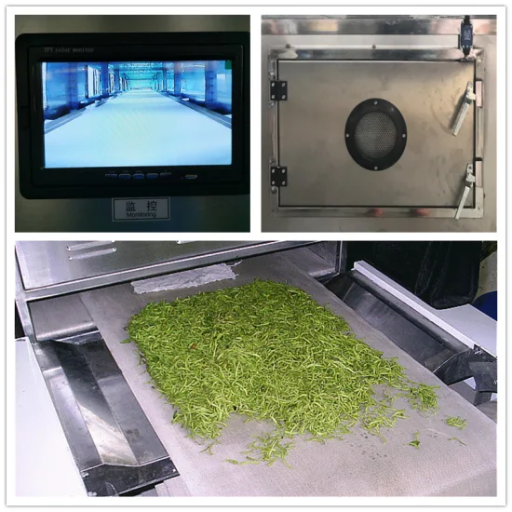Hello and welcome to our all-inclusive guide on microwaving moringa leaves sterilization machines. In this write-up, we will look in-depth into the technology, advantages, and uses of microwave equipment for sterilizing Moringa leaves. The high nutritional value and health benefits associated with Moringa leaves necessitate proper sterilization methods to ensure they are free from contaminants and safe for consumption. Producers can attain higher efficiency levels, work better, and preserve more nutrients using microwaves than conventional sterilization methods through food heating apparatuses. Whether you work in a food processing company, are just passionate about healthy living, or are curious, everything required to understand and embrace this new technique is presented in this article!
How Does a Microwave Moringa Leaf Sterilizer Work?

Image source: https://joyangmachine.en.made-in-china.com/
A sterilizer for microwave moringa leaves destroys harmful organisms by using microwaves to produce heat within the leaves. Putting the moringa leaves inside the sterilizer chamber is your first step. This radiation can pass through the leaves, causing water molecules in plant tissues to vibrate quickly. Then, this warmth spreads uniformly throughout all parts of a leaf due to this shaking process. Elevated temperature kills bacteria, fungi, and other microorganisms that may cause diseases, ensuring they are safe for use without losing their nutritional value. This method saves time and provides more nutrients and active ingredients that are preserved compared with traditional methods of sterilization for moringa leaves.
What Is Microwave Sterilization?
Microwave sterilization is an innovation that employs microwave energy in heating food products to kill all harmful microorganisms. Other sterilization methods rely on conduction and convection to facilitate the movement of heat from the exterior surface toward the inside parts. At the same time, microwaves directly contact the meal, causing vibration in water molecules and generating internal heat. This fast heating process, where every part gets heated equally, reduces the time for sterilizing by a significant margin, making it more effective without compromising on nutritional values and sensory properties of food during preservation. When dealing with moringa leaves, this technique guarantees safety and preserves necessary nutrients and biologically active substances through microwave treatment.
How Does Microwave Drying Enhance Sterilization?
Microwave drying is a technique that helps sterilization, using the properties peculiar to microwave energy to make the sterilizing process efficient and effective. This method makes Rapid and even heating possible by dehydrating leaves while destroying all disease-causing microorganisms. It works more effectively than other methods because it saves the time required for drying and killing germs since both actions are carried out separately. Compared with traditional ways, this technique enables us to keep more valuable elements alive during preservation, which happens alongside drying and killing bacteria. In addition, the loss of volatile compounds is reduced by microwave dryings; thus, the heat-labile nutrients remain stable, maintaining the nutritional value and potency of Moringa oleifera Lam leaves.
What Are the Key Components of a Microwave Sterilizing Machine?
These include the following:
- Microwave Generator: It generates microwaves that heat and sterilize food items. Usually, a magnetron or any other device for creating microwaves is used.
- Waveguide: This component directs waves from the generator into the sterilization chamber, distributing them evenly and effectively throughout its volume.
- Sterilization Chamber: The place where products are put to be disinfected using microwaving them. It is built in such a way as to provide maximum exposure area while containing and distributing heat uniformly within itself.
- Control System: A sophisticated monitoring system that controls microwave power, time, and temperature necessary for proper disinfection without damaging the nutritional properties of treated goods.
-
Cooling System (if applicable): In some models, this feature allows processed foods to be quickly cooled down after they are subjected to high temperatures during the cooking cycle, thus keeping their intactness and taste qualities safe.
What Are the Benefits of Using Industrial Microwave Sterilizing Equipment?
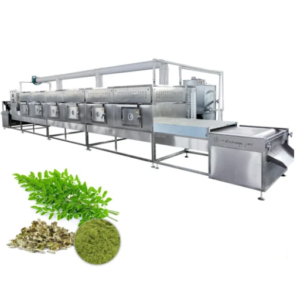
There are many benefits to using industrial microwave sterilizing equipment. First, it heats up fast and evenly compared to traditional methods, drastically reducing production time. Second, this allows food products’ nutritional quality to be preserved because there is less chance that they will be over-processed due to precise temperature control and timing. Thirdly, microwaves use less energy than other types of heat sources, making them more sustainable in the long run and cheaper to operate on an ongoing basis. Last but not least important is safety! Microwaving kills bacteria effectively, which means no contamination can occur during processing while keeping necessary features unimpaired.
How Does Industrial Microwave Sterilization Improve Efficiency?
Industrial microwave sterilization can improve efficiency in various significant ways. Unlike conventional methods where conduction or convection is used as a means through which heat reaches the product’s core, this technology can achieve rapid and uniform heating by directly penetrating it, reducing processing time significantly. This swiftness in heating also brings about a reduction in energy consumption, thus making it cost-effective, too. Moreover, control over parameters such as température and timing ensures consistency while minimizing wastage caused by over-processing since nutritional value and sensory qualities are maintained throughout the foodstuff microwaved. Additionally, pathogen elimination within the shortest possible period significantly contributes towards a safe & faster sterilization process, thereby enabling higher throughput and better resource utilization.
What Makes Microwave Moringa Leaf Powder Sterilization Equipment Stand Out?
The microwave system for sterilizing Moringa oleifera leaf powder is unique in that it kills germs well but keeps those leaves’ nutritional value and bright green color. This technique makes the heat even more distributed so that the process can take less time and save energy. Moreover, this device allows exact control of sterilization conditions, which ensures uniformly high-quality products every time. By preserving the nutritional facts and taste qualities inherent in Moringa Powder, microwave sterilization helps create better goods. What’s more, with microwaves, there is always an added level of safety during production because there are fewer chances for things to go wrong or become contaminated along the way, thus making this method widely used across various industries where food safety matters most.
Why Is Microwave Sterilization Equipment Essential in the Food Industry?
In the food industry, microwave sterilization equipment is essential as it kills bacteria fast and effectively – this is necessary to secure food safety and prolong its shelf life. This approach even involves heating, which saves much time for processing and cuts down energy consumption compared to other methods. Moreover, microwaves can ensure that the nutritional value of products remains intact while preserving their sensory qualities, thus not compromising marketability. It is possible to consistently achieve similar outcomes during sterilization due to accurate management of parameters involved, thereby reducing waste, which makes this procedure economical in terms of cost. With lower chances of getting infected and improved quality standards among products, microwave sterilization equipment helps meet reliable and efficient solutions for food processing within the industry.
How to Choose the Right Microwave Moringa Leaves Dryer and Sterilization Machine?

Consider some essential things when selecting an appropriate microwave for the Moringa leaves drying and sterilization machine. First, determine if the capacity of the equipment matches your production needs. Secondarily, assess its energy efficiency and operational costs to ensure it is cost-effective over time. Thirdly, check whether or not the device provides for accurate control of drying and sterilizing parameters so that uniformity and high quality are assured in products obtained through this process. Also, look at how easy the machinery can be operated and maintained which will help reduce on downtimes during operation thus making work easier for operators. Last but not least verify whether any certifications awarded alongside compliance with set standards in food hygiene among others may be applicable thereby ensuring safety while using these machines. By considering these factors, you can choose a suitable unit that will support your production line effectively and provide excellent quality Moringa leaf powder.
What Factors Should You Consider When Buying a Tunnel Microwave Dryer?
Consider these points when purchasing a tunnel microwave dryer:
- Capacity and Throughput: The dryer should be able to accommodate the required amount of products and match your production scale.
- Energy Efficiency: Look for machines with energy use optimization features, as this would reduce operational expenses over time.
- Control Systems: Sophisticated control systems enabling precise temperature adjustments, changes in microwave power levels, or conveyor speed are necessary for even drying results throughout.
- Material and Build Quality: Ensure that the materials used in its construction are strong enough to withstand wear and tear associated with industrial applications where such devices are commonly utilized.
- Maintenance and Cleaning: When deciding which dryer to buy in stores, choose those models that are easy to wash when dirty or perform routine maintenance practices. This can save time, especially during busy periods (e.g., peak season).
- Safety Features: Do not forget about safety! Ensure that any machine you settle for has adequate preventive measures to safeguard workers’ lives while they operate it.
-
Certifications and Compliance: Finally, always make sure that what you select is certified by relevant bodies like the FDA (Food Drug Administration) or ETL (Education Testing Laboratory). Thus, it meets industry standards set out concerning food safety rules plus other regulations relating to quality assurance systems within this sector.
How to Evaluate the Different Types of Industrial Microwave Sterilizers?
When you are analyzing different types of industrial microwave sterilizers, there are specific points that you should consider:
- Effectiveness of Sterilization: Review how each sterilizer efficiently gets rid of bacteria, viruses, and other microorganisms. Check machines that have proven themselves over time and provide microbial reduction data.
- Processing Capability: Assess the quantity of products a machine can handle within a given period. Ensure it matches your production capacity without slowing things down too much.
- Power Consumption: Examine various models’ energy efficiencies to help choose one that will save power while still performing well. Energy-saving models significantly cut operation costs.
- Control Systems and Monitoring: Some advanced models have controls that enable accurate adjustments and real-time monitoring, among others, so look out for such features since they guarantee uniformity in sterility maintenance and ease of use.
- Compatibility With Different Materials: Ensure a machine can handle all the materials or products you want to sterilize. Note that various materials may require different sterilizing protocols.
- Serviceability: Consider its cleanability and service availability; if possible, go for easily cleaned ones, which will reduce downtime and eventually extend their useful lives.
- Safety Measures: Assess whether operators are protected during work and environmental safety precautions taken by manufacturers to protect their employees’ health and welfare while at duty stations. For example, provision for an emergency stop button, among other things, would be appropriate here, as would proper shielding devices that must always remain operational when staff members remain exposed outside protective walls (where applicable).
- Compliance and Certification Statuses: Check whether it meets industry standards and regulatory demands regarding safety effectiveness certifications by recognized bodies. These may also give some assurance concerning the quality levels achieved so far.
Only through thorough consideration of these aspects can one choose an industrial microwave sterilizer suitable for them, which will ensure efficient, safe, and reliable sterile processes.
What Is the Role of Moringa Leaf Powder Industrial Microwave Machinery?
Machines for microwave industrial moringa leaf powder are essential in effectively turning moringa leaves into powdered form. These modern devices use energy from microwaves to quickly and uniformly dry the leaves, thereby retaining their nutritional value and improving the ultimate quality of the product. The microwave drying method is faster than any other traditional ways; it also consumes less power, thus cutting down on costs incurred during production while at the same time minimizing environmental pollution levels caused by electricity usage. Moreover, these appliances have been designed to keep intact all the natural color variations, flavors, and bioactive compounds found within moringa so that one ends up with a high-quality, marketable item.
How Can You Ensure Proper Maintenance of Microwave Sterilizing Equipment?
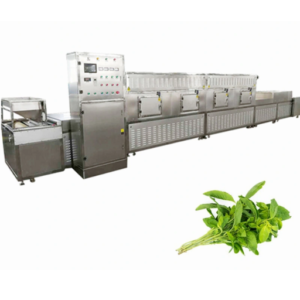
Typical maintenance measures for a microwave dryer include:
- General cleaning: Clean the microwave dryer regularly to remove dust, debris, and product residues. This prevents accumulation that may affect its operation and ensures it works uniformly well. Always ensure that you follow safe cleaning practices as recommended by the manufacturer.
- Regular checks: Perform routine visual checks on the equipment to identify any signs of tear, wear, damage, or potential problems. Discovering an issue early can save on costly repairs and reduce downtime.
- Testing components: Periodically test all parts, such as fans, conveyor belts, and the microwave generator, to verify their proper functioning. Replace or repair any faulty component immediately so as not to compromise efficiency in operation.
- Calibration and Testing: It is essential to calibrate the system regularly for accurate temperature control ability alongside humidity management during the drying process. Consistent calibration helps keep drying quality high while saving energy, too.
- Ventilation system maintenance: Ensure that the ventilation system is clean and clear. Good airflow is essential in preventing overheating, which might harm or even kill users, thus compromising the machines’ safety standards and efficiency levels.
- Lubrication for moving parts: Apply lubricants to moving parts according to the manufacturer’s instructions, thereby reducing frictional forces between them and minimizing the chances of mechanical breakdowns.
- Software and Firmware Update: Keep updating machine software and firmware with the latest patches, which include improved functionality features and security fixes. This would enable better performance outcomes and ensure safety standards are met at all times.
- User training: Train every user about correct usage methods and maintenance procedures so they do not misuse it, hence shortening its lifespan unnecessarily.
Following these tips will help you get more out of your microwave dryer machine in terms of performance and longevity.
How Often Should You Service Your Microwave Sterilization Equipment?
How often you should service your microwave sterilizer depends on the manufacturer’s recommendations, how frequently it is used, and the environment in which it operates. In general, regular checks for essential maintenance are recommended each month. This may involve looking over certain parts, cleaning them, or testing their performance visually. More thorough servicing that includes detailed inspection and possible replacement of components should occur every six months up until a year apart. Beyond this point, additional inspections may need to take place if higher usage or more extreme conditions are present. Always consult with user manuals for specific instructions on each model and follow producers’ schedules so as not to have unexpected breakdowns, which could shorten the life span of the equipment.
What Are the Signs That Your Sterilizing Machine Needs Repair?
To avoid major breakdowns and keep it running, one must be able to detect the initial signs of malfunctioning in a sterilization machine. Here are some common indicators that could tell you if your equipment needs fixing or not:
- Inconsistent Sterilizing Cycles: When cycle times vary, or they fail to complete altogether, there could be a problem with the sensors and control systems of the machinery.
- Abnormal Sounds: Grating, banging, or screeching sounds while it is being used may mean mechanical faults or worn-out parts that require attention.
- Temperature Changes: Defective heating elements or temperature sensors can lead to inconsistent or wrong temperatures during sterilization cycles.
- Error Messages: The frequent appearance of error codes or alarms indicates that something within the apparatus is not functioning as expected.
- Poor Seal and Low Pressure: Steam/liquid leakages usually show compromised seals,, which can greatly affect a machine’s sterility levels.
- High Power Consumption Rates: When energy usage suddenly increases, the device might need servicing or part replacement, which suggests inefficiencies within the device.
Consulting the user guide booklets and manuals could help address these problems early, thereby saving your sterilizer further damage.
What Are the Safety Concerns When Using Microwave Drying Sterilization Equipment?
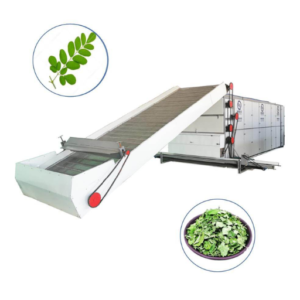
There are a variety of safety concerns to keep in mind when using microwave drying sterilization equipment:
- Radiation Exposure: Make sure the machine is well-shielded and maintained regularly so that no microwave radiation leaks; exposure to this can be hazardous.
- Overheating: Be careful not to let it get too hot, as this could cause damage or even start fires. You should have a way of monitoring its temperature and shutting it off automatically if necessary.
- Electricity Safety: Since these devices use a lot of power, there needs to be proper adherence to electrical safety standards not to create short circuits or deliver electric shocks.
- Proper Ventilation: Good airflow is essential to avoid the build-up of noxious fumes or gases that may be released during drying and sterilizing procedures.
- Personnel Training: Those who operate them must know how best to do so without putting themselves or others at risk. Hence, they should undergo adequate training and always follow the manufacturer’s instructions, among other protocols.
These precautions will help lower the chances while also ensuring efficiency in running this type of drying equipment through radiation.
What Safety Measures Should Be Taken Before Operating the Equipment?
Before using the microwave dryer, there are a few essential precautions should be taken:
- Equipment inspection: The equipment needs to be carefully examined, and any visible damage, such as cracks or loose connections, that may affect its safe operation should be identified.
- Ensure proper shielding: All shield components must be checked to ensure they are in place and functioning well so as not to leak microwave radiation.
- Proper grounding: Ensure the machine is grounded correctly to avoid electric shock or short-circuiting.
- Read the user manual: Go through operational procedures, manufacturer’s instructions, and safety precautions provided by this document.
- Use necessary PPE: Operators should wear the recommended personal protective gear, like gloves, goggles, etc., to protect themselves against hazards.
- Set clear operation guidelines: To minimize the risks involved, establish strict rules for how it should work, including regular maintenance checks and emergency shutdown protocols.
- Ventilation confirmation: A properly aerated working environment during the heating process prevents the accumulation of toxic fumes or gases produced after that.
Following these steps will help you eliminate most accidents while operating this device safely.
How to Safely Handle Microwave Sterilizing Machines?
To handle microwave sterilization devices safely, one must go through some steps:
- Certification and Training: All operators should be trained to handle these machines securely.
- Frequent Maintenance: Perform regular checks of the machines for maintenance based on what manufacturers recommend to ensure that they are always in good working condition.
- Use within a Controlled Environment: The machine should only be operated within a controlled environment where unauthorized persons have limited access.
- Follow Operating Procedures: Strictly adhere to the operational procedures provided in the user manual, such as pre-operational checks, loading protocols, and process monitoring.
- Emergency Preparedness: Always be ready for any emergency by having clear protocols and ensuring all operators can execute an emergency shutdown or use a fire extinguisher.
- Monitor for Malfunctions: Keep a close eye on equipment while working out. If there is any sign of malfunction or unusual behavior, then stop it immediately when noticed.
- Implement Quality Control Measures: Put into practice quality control measures which will see to it that each cycle of sterilization meets required standards without compromising safety as well as effectiveness otherwise;
By following these instructions attentively, you will reduce dangers and promote the safe operation of microwave sterilizing machines.
What Are the Potential Risks of Microwave Drying and Sterilizing?
To guarantee the safety and efficacy of microwave drying and sterilization, operators must be familiar with several possible hazards. Among the many dangers is irregular heating, which can cause both cold spots and hotspots in the material, leading to incomplete sterilization and poor-quality products. Also, this disproportionate distribution may result in thermal damage to delicate parts or substances. Moreover, equipment malfunctioning poses another significant risk, where breakdowns or failures in technology could lead to overheating and spark fire outbreaks, hence requiring immediate attention coupled with regular maintenance practices to prevent such hazards. Last but not least, exposure to microwave radiation is a major concern for safety. Although modern-day microwaves were designed keeping radiation containment in mind but still if shielding gets damaged somehow or misuse occurs by operators, then they might get exposed to harmful microwave radiations; therefore, strict safety procedures should always be followed when using equipment of this kind together with their proper care and maintenance being observed all times.
What Is the Process of Microwave Sterilization of Moringa Leaves?
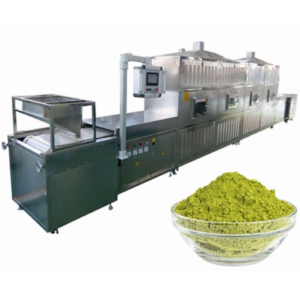
It typically goes through some crucial stages to make the microwave sterilization of Moringa leaves successful and safe. Firstly, fresh leaves are collected and cleaned well to remove dirt, debris, or microorganisms on their surfaces. Hence, having been cleaned, they are spread evenly in a thin layer for uniform exposure to microwave radiation. The microwave sterilizer is preheated and then set at the correct power level and duration depending on specific parameters for Moringa leaves. In the course of sterilizing them with microwaves, these rays warm up the leaves quickly and evenly, which disrupts bacteria cells, causing their death, hence eventually making the leaves sterile. After finishing this process, allow moringa leaf to cool down to room temperature before packaging or further processing takes place around it. This approach ensures that while valuable nutrients and properties of moringas remain intact, they also get enough heat treatment to kill all germs.
How Is Microwave Moringa Leaf Sterilization Different from Conventional Methods?
Compared to conventional methods such as steam or chemical sterilization, microwave sterilization of moringa leaves is characterized by many differences. First, it operates more rapidly since heating is done directly and evenly at the molecular level, thus reducing process time significantly. In this case, rapid warming destroys microorganisms effectively while minimizing heat injury on leaves. Unlike these methods, where exposure to high temperatures or chemicals may be prolonged nutritionally and sensorially lowering properties of leaves, the energy-saving method involves intermittent bursts of power. Secondly, steam sterilization requires more energy and water than microwave treatment, saving costs and environmental resources. Finally, microwave technology’s precision enables better control over sterilization parameters, leading to uniform outcomes, thus improving final product quality.
What Steps Are Involved in the Sterilization Process?
The process of sterilization through microwaves is composed of some essential steps:
- Preparation of Leaves: First, remove all the dirt, dust, or other unwanted particles from the moringa leaves by washing them thoroughly and letting them dry.
- Placement in Microwave Chamber: Arrange the cleaned leaves evenly inside a microwave sterilizing chamber. Ensure that they are distributed uniformly, as this will facilitate equal heating.
- Microwave Exposure: At this stage, the leaves are subjected to radiation emitted by microwaves, which heats them up fast and equally. In effect, such a step alters microorganisms’ cellular structure, thereby destroying them completely.
- Cooling: When treated with microwaves, these should be allowed to cool down until they reach the temperature of the surrounding environment. This will stabilize their condition and retain the nutritional properties inherent in those plants.
- Packaging: Once cooled, packaging follows immediately afterward for convenience’s sake. More specifically, one has to seal tightly sterilized moringa leaves so that no impurities can come into contact with them from there onward until consumption time comes.
Following these stages carefully ensures good sterility levels while retaining beneficial qualities in moringas, making this method efficient and eco-friendly.
What Are the Best Practices for Effective Sterilization of Moringa Leaves?
There are several ways to ensure that moringa leaves are adequately sterilized so as not to lose any nutrients while still being able to kill all bacteria. First, one must get fresh, high-quality moringa leaves free from impurities. These can be washed well using clean running water, which helps remove dirt particles or other unwanted materials. For microwave sterilization, setting the temperature right and selecting the time duration is crucial – high power for short periods usually works best. Placing them uniformly in layers ensures even exposure throughout, thus making the process effective. A food thermometer may be used to check the temperature, which should constantly be monitored, considering optimum conditions. In addition, ensure that cooled down in an area where there is no dust or anything; hence, recontamination does not occur again after they have been cleaned up once more. At this stage, after all these steps have been followed through, then it would be safe enough to pack them into air-tight containers for storage purposes because this will help retain their good state longer while also increasing shelf life span if done rightly so air does not get into contact directly with the outside environment since some parts might rot quickly if exposed too long without being used up first always try keeping such things sealed tightly away somewhere dry but cool as well. By following those simple rules, we can increase the nutritional value of Moringa leaves during the sterilizing process.
Frequently Asked Questions (FAQs)
Q: What is Microwave Moringa Leaves Sterilization Equipment?
A: Microwave Moringa, Leaves Sterilization Equipment, is advanced machinery for drying and sterilizing moringa leaves. It utilizes microwave technology to ensure thorough sterilization and drying, preserving the leaves’ nutritional content.
Q: How does a Microwave Drying and Sterilizing Machine work?
A: A Microwave Drying and Sterilizing Machine uses microwave radiation to heat and evaporate moisture from moringa leaves. The heat also effectively kills harmful microorganisms, providing both drying and sterilization in a single process.
Q: What are the benefits of using a Moringa Leaves Microwave Drying Equipment?
A: The benefits include faster drying times, retention of nutritional content, thorough sterilization, and reduced energy consumption. The equipment ensures high-quality moringa leaf powder with enhanced shelf life.
Q: What is the difference between an Industrial Microwave Drying Machine and a conventional drying machine?
A: Industrial Microwave Drying Machines use microwave energy, which heats the leaves from the inside out, resulting in faster and more uniform drying. Conventional drying machines typically use hot air, which can take longer and may cause uneven drying.
Q: Why should I choose Shandong Loyal Industrial microwave drying equipment?
A: Shandong Loyal Industrial provides high-quality, reliable microwave drying and sterilizing machines. Their equipment ensures efficient processing, retaining the nutritional content of moringa leaves while providing thorough sterilization.
Q: Can microwave sterilization equipment be used for other food processing applications?
A: Yes, microwave sterilization equipment can be used in various food processing applications beyond moringa leaves. It is suitable for drying and sterilizing different food products, ensuring safety and quality.
Q: Is there microwave sterilization equipment for sale for small-scale operations?
A: Yes, microwave sterilization equipment is available for both small-scale and industrial-scale operations. Models designed for different capacities and requirements, including powder microwave and leaf microwave equipment, are available.
Q: What is the role of advanced microwave and sterilization technology in drying moringa leaves?
A: Advanced microwave and sterilization technology is crucial in efficiently drying moringa leaves while preserving their nutritional content. It ensures the leaves are thoroughly sterilized, making them safe for consumption and further processing into moringa powder.
Q: What factors should I consider when selecting a leaf powder industrial microwave dryer?
A: When selecting a leaf powder industrial microwave dryer, consider factors such as capacity, energy efficiency, ease of operation, thorough drying and sterilization, and the supplier’s reputation. Shandong Loyal Industrial offers reliable options that meet these criteria.
Q: How do I ensure the maintenance and longevity of my Microwave Drying and Sterilizing Machine?
A: To ensure the maintenance and longevity of your Microwave Drying and Sterilizing Machine, follow the manufacturer’s guidelines for regular cleaning, servicing, and inspection. Proper maintenance helps in extending the equipment’s lifespan and performance.













